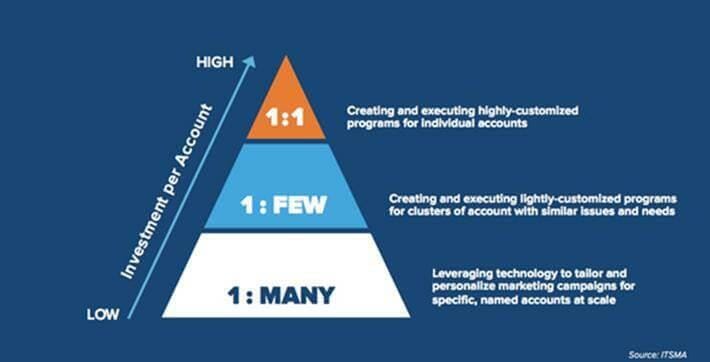How much should marketing contribute to sales pipeline?

Table of Contents
The marketing department is expected to source some sales pipeline. I was wondering what a healthy contribution looks like and did some research. Today, I’ll share the results and also what I’ve seen from my years of experience in B2B marketing. So, how much should marketing contribute to the sales pipeline?
In a mature sales territory, the marketing department should source 25-30% of the total sales pipeline. In a new sales territory, marketing should contribute around 40% of the total sales pipeline.
These numbers are marketing contribution benchmarks based on research by SiriusDecisions and the Revenue Marketing Benchmark Report. This report is put together by Marketo and Demand Spring.
Of course, there are many nuances to take into account. The marketing contribution to the sales pipeline will depend on the maturity of sales regions. Also, the contribution varies by net new customers and existing customers.
So let’s take a look at those variations as well as some tips on how you can measure your marketing contribution to the sales pipeline.
Marketing contribution nuances
It’s not as straightforward as saying that marketing should always contribute 30% of the sales pipeline. There are some factors that must be taken into account.
Net New Customer vs Existing Customers
The impact of the marketing department will be larger on deals that focus on acquiring new customers.
Especially SaaS companies have a large focus on acquiring new customers. This also means that most of the sales resources are directed towards new customers.
Marketing should contribute about 25-30% to the sales pipeline that focuses on new customers.
In B2B organizations, when new customers are acquired, the customer success team will often take over. Together with sales, they are also responsible for expanding that account.
However, when it’s a very large account with big upsell potential, marketing might get involved.
At account with a big upsell potential, B2B organizations often set up virtual teams. These teams include members of sales, marketing, customer success, and the channel team. The goal of this team is to upsell the customer to a very large deal.
This is part of an account-based marketing strategy; known as the one-to-one approach.

Marketing will be responsible to contribute to the upsell or expand pipeline at existing customers. In general, marketing is expected to contribute 15-20% to the sales pipeline focused on upselling existing customers.
Maturity of sales regions
The maturity of sales regions also affects how much marketing is expected to contribute to the regional sales pipeline.
In mature sales territories, the benchmark is that marketing contributes about 25-30% to the new customer sales pipeline. In these regions, the sales team is large and the partner ecosystem is up and running. They will bring in the majority of the sales pipeline.
In less mature markets, the marketing contribution is expected to be higher. A healthy marketing contribution to sales in new sales regions is about 40-45%.
The reason why this is higher has two main reasons:
- There is no partner ecosystem. This means that marketing and sales are responsible for generating sales pipeline. This naturally means that more is expected of marketing and sales.
- The marketing investment will be higher to facilitate growth. With a larger investment, you can generate more leads and sales opportunities.
Go-to-Market Strategies
The percentage of leads coming from marketing also depends on the go-to-market strategy.
SiriusDecision calls this the Modeled Approach to Marketing's Contribution. Basically they have defined three tiers of GTMs, namely:
- Direct Enterprise Accounts;
- Inside Commercial Accounts;
- SMB/Channel Accounts.
The idea is that for Direct Enterprise Accounts are often familiar accounts. This means that many of the leads have already been generated in that account. There is simply not much left to generate. This means that the marketing contribution to the sales pipeline will be lower. About 10%. However, marketing influences about 75% of the leads in that account.
Inside Commercial Accounts are companies between 100-1000 employees. Here marketing is expected to source about 25% of all the leads.
In SMB/Channel Accounts marketing is responsible to generate about 40% of all the leads. The lead pool is much larger here and that’s why marketing is expected to contribute more to the sales pipeline.
The go-to-market strategy will also depend on economic conditions. For example, in a recession sales strategy might differ. Marketing in a recession is a challenge but it also provides opportunities.
What is a healthy pipeline contribution split?
Naturally, marketing will never be responsible to generate the full sales pipeline.
At the end of the day, sales will always be responsible for their own pipeline. Marketing helps.
When taking a look at B2B organizations, there are a couple of parties contribution to sales pipeline; namely:
- (Inside) Sales;
- Marketing;
- Channel.
In a mature sales territory, each party is expected to contribute the below percentages to sales.
- (Inside) Sales: 40%
- Marketing: 30%
- Channel: 30%
In less mature sales regions, this changes significantly.
- (Inside) Sales: 45-50%
- Marketing: 45-45%
- Channel: 5-10%
Of course, there will be nuances depending on your company and your offerings.
Marketing sourced pipeline vs influenced pipeline
Most of the numbers mentioned in this article are based on the marketing sourced pipeline. This is often confused with marketing influenced pipeline. The difference between them is massive so let’s spend some time understanding them.
Marketing sourced pipeline is sales pipeline generated by initiatives driven by the marketing department. The marketing department is the initiator of the campaign or event. The leads generated by these campaigns are marketing sourced.
The sales opportunity wouldn’t exist without the marketing department.
Marketing influenced pipeline is sales pipeline where marketing has influenced main contacts in the opportunity. So let’s say that your sales team is in the middle of a sales cycle.
The main contacts of that sales opportunity visit your website and download a bunch of whitepapers. As they’ve engaged with some of your marketing campaigns, this is now marketing influenced.
Sales cycles at B2B organizations are often quite complex and might take months to complete. Throughout the duration of the sales cycle, the chances are very high that people from that account engage with some marketing campaigns. So in reality, almost all sales cycles are marketing influenced.
How to measure marketing contribution?
The marketing contribution to the sales pipeline can be hard to measure. Many times, CRMs are not set up properly and with the correct attribution models.
Basically, attribution provides understanding which marketing touches led to the desired outcome.
In B2B marketing, a large number of opportunities will come from B2B events. The field marketing department has a good understanding of which leads are generated from events.
It’s wise to include a field on your CRM where you can enter the primary campaign source of an opportunity. The field marketing department can use this field to register opportunities generated by events. This helps to prove the ROI of events.

This will not be a lot of work for your field marketing teams and it will greatly improve visibility into marketing effectiveness.
The field marketers are the people who work with the sales team. They are the people that need to prove how much they are contributing to the sales pipeline. If they can’t do this, it will destroy the relationship with sales. So give your field marketing team the tools they need to report on marketing contribution.

Share this article



